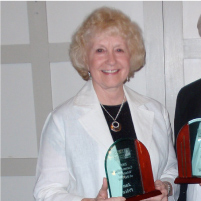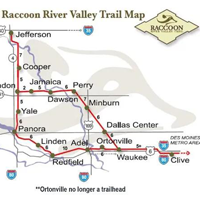Jan Price and the History of Adel, Iowa
Reissued from the DiscoverAdel.com April 2009 Newsletter
DiscoverAdel.com has asked Jan Price of the Adel Historical Society to help showcase this theme by highlighting the historical points of reference throughout the history of Adel.
Jan has been the volunteer manager of the historical museum for the past 4 years. She grew up in Adel, and recently returned to the community with her husband Donald in 1999.
When they retired, after more than 30 years of professional careers in education, they moved to Adel and purchased a home on Locust Street.
Jan and Donald love living in Adel and have become active in various organizations. Jan was gracious enough to help DiscoverAdel readers answer the questions of how this small community came to be.
Q.What is a brief history of Adel?
Dallas County was made available for settlement on April 30, 1843. A year previous the land was purchased from the Sac and Fox Indians and it was stipulated in the contract that all Indians were to be removed within a period of 3 years.
In 1846 Iowa was admitted into the United States. James Polk was President and the Vice President was George Mifflin Dallas. Our county was named after him.
In 1846 our county was organized. The first settler in Adel Township was Samuel Miller who settled in what became known as the Miller Settlement. It was a short distance east of where Adel was later built.
There is a stone monument on the north side of Highway 6 marking the settlement and the Miller cemetery is on the south side of the highway. There the first sheriff of Adel, Jesse K. Miller, is buried. Samuel Miller built his log cabin during the winter of 1847-48 and used it for the 1st schoolhouse in Dallas County.
In 1847 a new town given the name of Penoach, an Indian word meaning “far away” came into existence. The original town plot extended from the Raccoon River to High (11th) Street and from Grove Street south to Greene Street.
This town not only became Dallas County’s first settlement to be classed as a town but it was selected as the county seat by the state legislature that same year. About 2 years afterward in the fall of 1849 the name of Penoach was changed to Adel in honor of “a very pretty child with a prettier mother”.
Q. Who can be considered the “Founding Fathers” of Adel?
Leroy Lambert: During his life in Dallas County, he was one of the leading businessmen.
He was elected to the state legislature in 1853,1858, 1860, 1861, and 1869. In 1868 he entered into banking opening the first bank in Dexter, Iowa with Martin Smith. Later, in 1869 they opened the Dallas County Bank in Adel.
In 1850 he was active in starting up the Christian Church.
Dr. T. J. Caldwell came to Adel in 1853. He was repeatedly elected to Mayor. He was the president of the railroad built from Waukee to Adel and continued its president until after its extension to Jefferson.
He was for many years the president of the Adel State Bank.
S.H. Greene was one of the first settlers in Adel. He was a promoter of Adel’s early railroad. His store was located where the jail now stands. Greene Street was named after him.
He was the father of Arletta Clarke who married Governor George Washington Clarke. They were the grandparents of Nile Kinnick.
J.B. White was a lawyer of unusual ability and also a man of rank in literary circles.
He taught school in Adel in 1873 and was active in business, civic political education, and religious and social matters.
George Washington Clarke moved to Adel in 1877. He served four years as Justice of the Peace and in 1882 formed a law partnership with John B. White.
He was successful in the legal field. He was twice the speaker of the House of Representatives. He was Lieutenant Governor from 1909-1913 and became the 21st Governor of Iowa for 2 terms from 1913 to 1917. After stepping down as Governor, he was Dean of Drake University Law School from 1917-18 and practiced law in Des Moines.
Q. How was Downtown established?
A state road was established across the state of Iowa and passed through Adel. This road from the East crosses the Raccoon River by ferry, and then followed, what is now Main Street on west, to California. It was heavily traveled during the “Gold Rush”.
The third courthouse was located in the same place that the current courthouse is located. It was here that the downtown began to develop. The original town plot extended from the North Raccoon River to High (11th) Street and from Grove Street south to Greene Street.
Q. When did the Dallas County Fair begin?
The Agriculture Society was organized in Adel on December 31, 1855. Archibald Crowe was elected chairman responsible for organizing the very first fair. In 1903, twenty-three acres on the north side of town was purchased for $3,200.00. With the exception of a few years, the fairs were held on this land, which became know as Riverside Park (now Kinnick Feller Park).
Q. How did the Adel Historical Society enter the picture?
The Adel Historical Society was organized September 26, 1972 with 30 charter members. They purchased the building that stands at 1128 Main Street.
This two-story brick building, built in 1857, was used as the second Adel schoolhouse for 12 years and then for many years after that as a residence for different families. For 26 years the Society used this building as its headquarters, improving the structure, collecting antiques and using the building for card parties, potlucks and other activities to raise money to support the museum.
In October of 1998 the Society disbanded, deeding its 129-year-old schoolhouse to the city. The city raised money along with a $7,000.00 grant given by the State Historical Society of Iowa for a new roof and a heating, cooling and ventilation system. Main Street Chamber Offices were located in the building. More renovations were made as contributions came in.
The Chamber offices were later moved to the new city hall (the former Adel Manufacturing Company making bonnets and gloves). The former chamber offices were made into a museum shop where many items relating to Adel are sold.
The upkeep for the museum is now paid for by the City of Adel. The museum contains 8 rooms filled with artifacts from the history of Adel.
The museum is run by a volunteer manager with the support of a Museum Committee consisting of members from three Questers’ organizations: Like Skillet, Raccoon Valley and George Mifflin Dallas. Donations are given regularly by Adel Women’s Club, the Questers’ groups and the Adel Historic Preservation Commission.
Volunteers throughout the community help with opening and manning the museum on Saturdays from May to September. Other times the museum may be toured by reservation by calling 993-1032. The two main events of the Adel Historical Museum are the Holiday Home Tour in December and the Corn Festival in August.
Q. What is the Adel Historic Preservation Commission?
The commission was formed in the mid 1990s by the Adel City Council. In 2002 the commission received a grant from the State Historic Preservation Office of the State Historical Society of Iowa (SHPO) to do an intensive survey and evaluation of the downtown commercial district surrounding the courthouse.
In 2006 the commission received another grant from the SHPO to nominate the Adel Public Square District to the National Register of Historic Places. The nomination was to be completed in June of 2008. As of this date the commission is waiting for word that Adel has received the nomination. The Courthouse and the Wagon Bridge are already on the National Register.
Q. What is Adel’s connection to the Circus?
Ortonville, located between Adel and Waukee on Highway 6 was named after Hiram Orton, who moved to the site in 1866.
But Ortonville wasn’t just any town. It was home to a traveling circus show that started in 1852. Orton purchased nearly 200 acres as the winter headquarters for the circus.
At one time the community of Ortonville included a cafe and grocery store, gasoline station, elevator, post office, stockyard and two telephone companies.
The show animals were over wintered at Ortonville because the fertile soil provided good crops and grain for the animals. The circus traveled by horse drawn wagon from one community to the next, making their way throughout the upper Midwest. According to one source, the Orton Circus was the largest wagon circus in the world.
Animals in the circus included monkeys, horses, elephants, lions, dogs, camels, tigers and leopards. Additional entertainment was provided by a band, trapeze artists, tight wire and slack wire walkers, swinging ladder and rolling globe performers, contortionists and acrobats.
Q. What are some of the historic aspects of town?
J. C. Corbell built the first house in the town in the fall of 1847. It was used as a dwelling house and post office. The first brick building in the town was a one-story structure occupied for many year by G. W. Campbell who operated a tailor shop.
The first two-story building was the school built in 1857. The first hotel in the town was a small story and half house managed by R.R. Bailey. Soon afterward Jacob Frush built the Plank House which was the temporary home of many pioneer travelers and also headquarters for the first station west of Des Moines on the stage coach line.
The first church in Adel was the Christian Church organized in 1847 by Elder John P. Glenn. The Presbyterians started a church in 1856, as did the Methodists about the same year.
The first newspaper in Adel was “The Ship of State” published in 1856. The first bank was established in the early 1850s by J. R. Van Meter. The first electric light plant was built by W. W. Hancock and L. M. Macy. The first flourmill was built in 1856 by J. H. Strong and J. H. Moffatt. The first tile and brick factory was started by Kerns and Hubbard in 1882.
Q. What can you tell us about the Nile Kinnick Museum?
Currently, we do not have a Nile Kinnick Museum. We have an Adel Historic Museum at 1129 Main Street, but we have begun to talk about building on a Nile Kinnick addition to the 1857 schoolhouse.
There is to be an auction April 20th at which time three items will be up for sale: A 1940 American Legion Program signed by Nile Kinnick, Nile Kinnick’s 1939 Iowa University Letterman’s sweater and a 1935 high school football leather helmet probably used by him when he played football in Adel.
We would like to purchase these three items for the future museum addition but presume they will go for a very high sum.
To find out how to help in this effort, or for tour information contact Jan Price at 993-1032.
Adel Historical Museum
1129 Main Street
Adel, Iowa 50003
515-993-1032







